Crusty Artisan Bread
This post may contain affiliate links. Read my full disclosure policy.
This crusty bread recipe is astonishingly easy—no kneading required—and makes three beautiful loaves, which you can bake as needed.
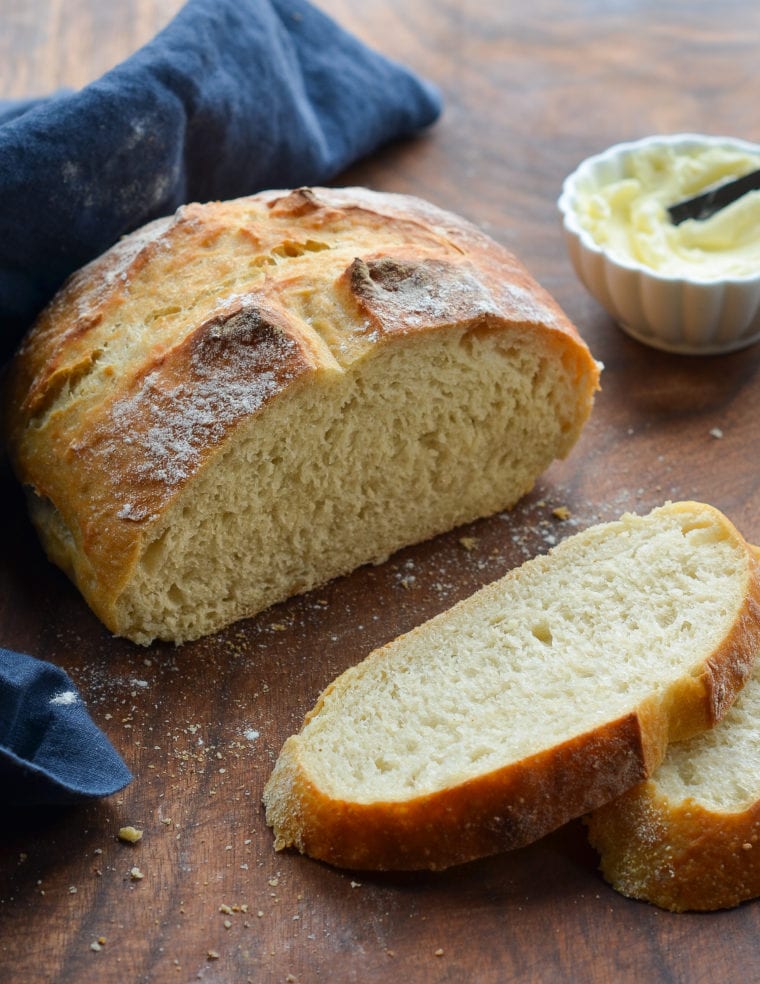
This homemade artisan bread recipe is astonishingly easy, and it makes enough for three delicious loaves, which you can bake as needed. What’s more, the dough takes just five minutes to make, does not require kneading or any special equipment, and can rest in the fridge for up to two weeks (the flavor becomes more complex the longer it sits). The recipe is modestly adapted from one of my favorite baking books, Artisan Bread in 5 Minutes A Day by Jeff Hertzberg M.D. and Zoë François.
What You’ll Need To Make Crusty Artisan Bread
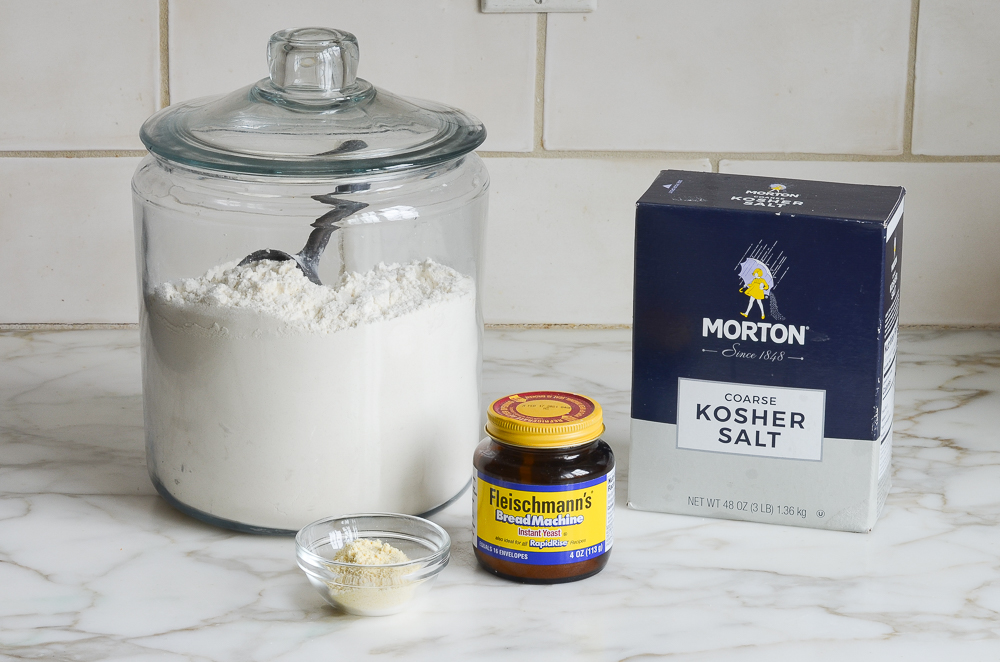
- All-purpose flour: Forms the structure of the bread; using high-protein flour, such as King Arthur, yields better results. If using a lower-protein flour, you may need to add a few more tablespoons of flour.
- Kosher salt: Enhances flavor and controls yeast activity; essential for a well-balanced taste.
- Instant/rapid-rise yeast: Leavens the dough, helping it to rise quickly without needing to activate it in water beforehand. Active dry yeast can be used instead, but it requires longer rising time. To activate, dissolve it in lukewarm water and let it sit until frothy before adding to the flour mixture.
- Lukewarm water: Hydrates the flour and yeast, helping to create the right dough consistency; lukewarm water (about 100°F) is ideal for activating the yeast.
- Cornmeal: Used for dusting the baking sheet to prevent the dough from sticking and to add a slight crunch to the crust.
- Jump to the printable recipe for precise measurements
Step-by-Step Instructions
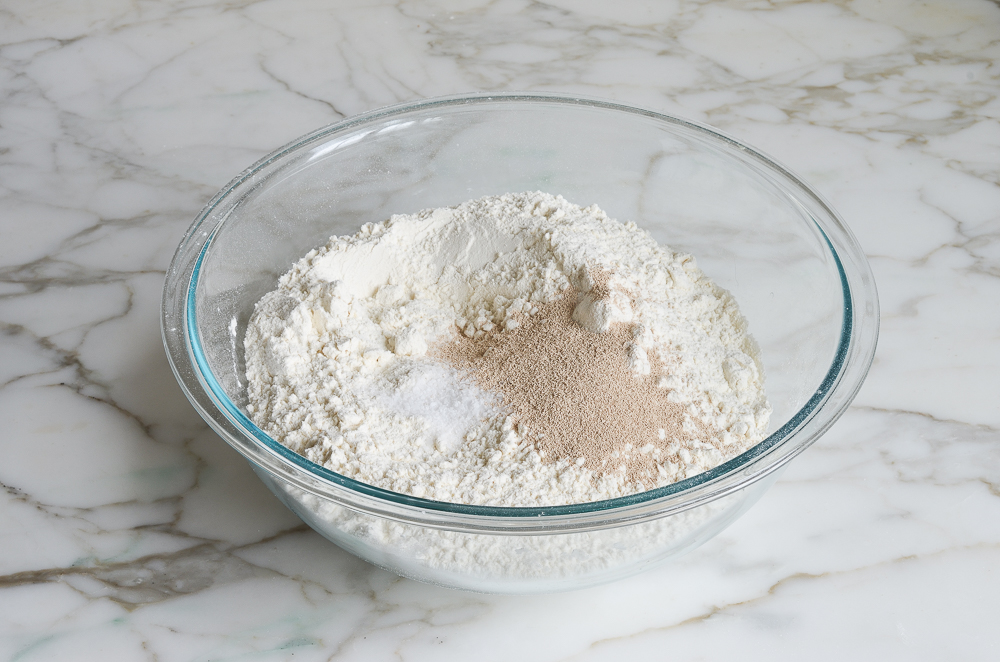
In a very large (6-quart) bowl, combine the flour, salt, and yeast. Mix to combine.
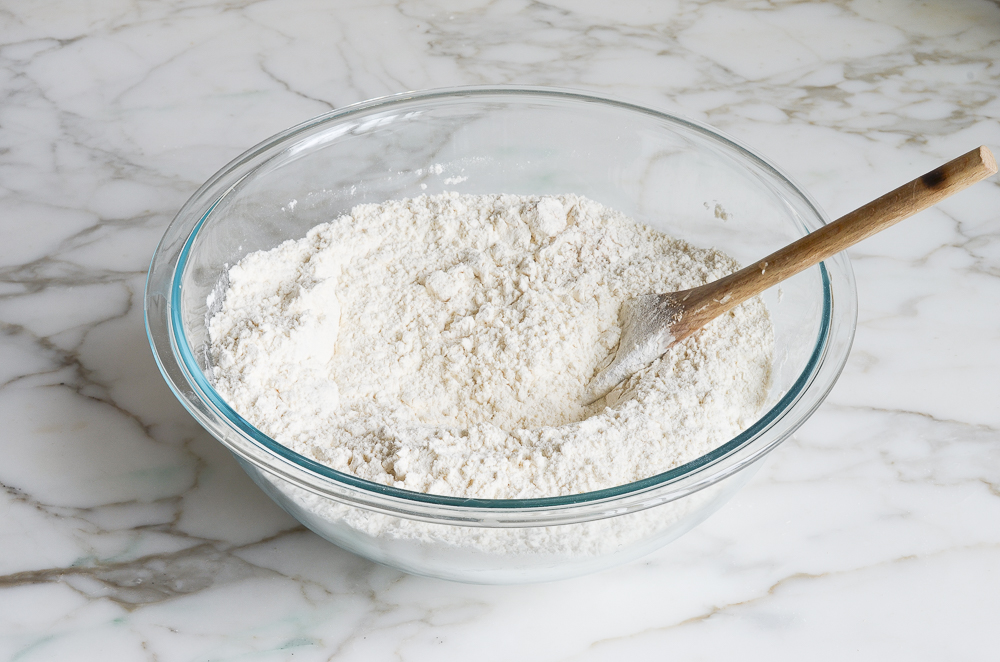
Add 3 cups of lukewarm water (no need to be exact but lukewarm is about 100°F).
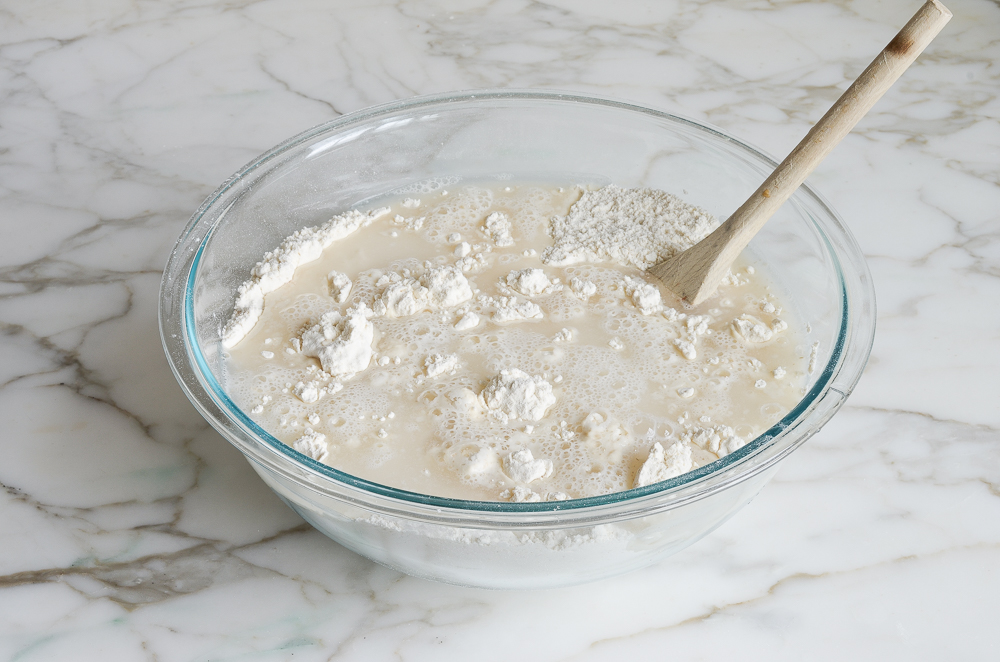
Stir with a wooden spoon until the mixture is uniformly moist, without any patches of flour.
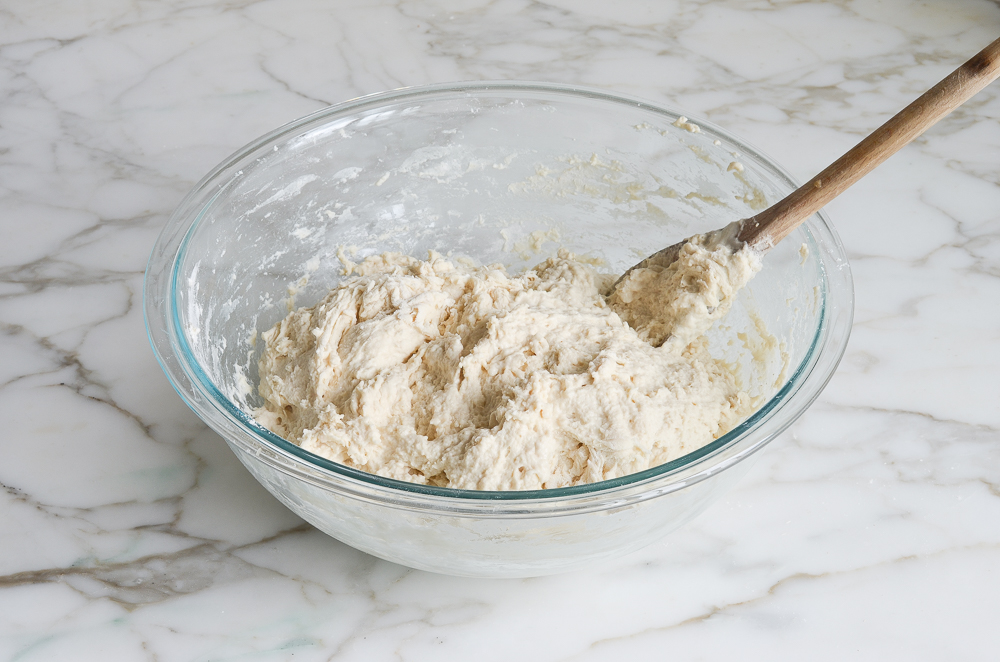
The dough should be sticky and conform to the shape of the bowl. If your dough is too dry, add a few tablespoons more warm water. If it’s too wet, add a few tablespoons of flour. Cover the bowl loosely with plastic wrap and let it sit on the counter in a warm spot for 2 hours. As you can see below, it will rise a lot!
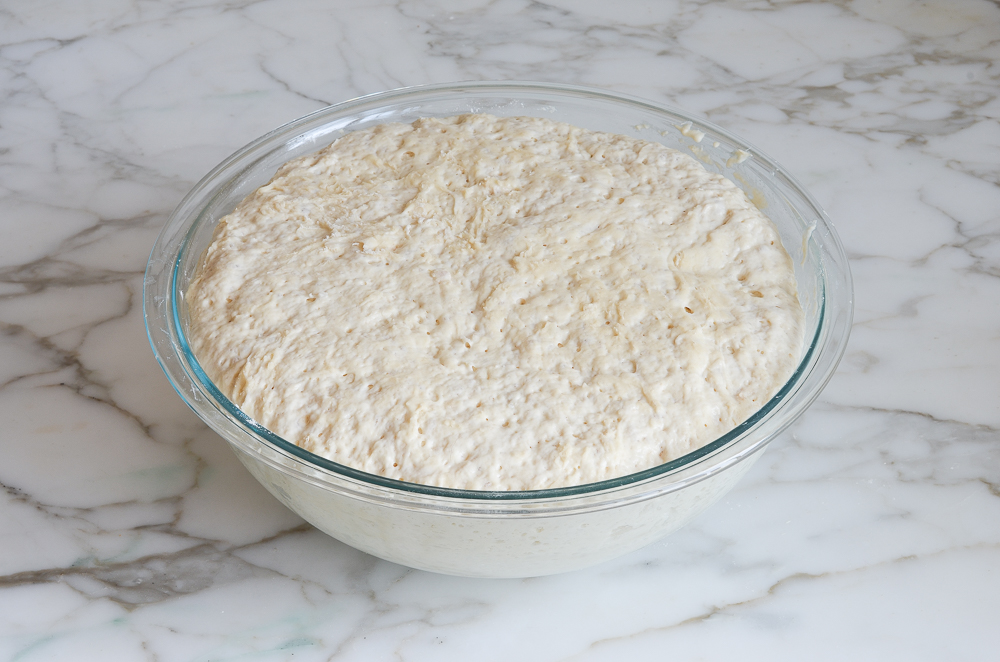
When you’re ready to bake a loaf, pull out one-third of the dough.
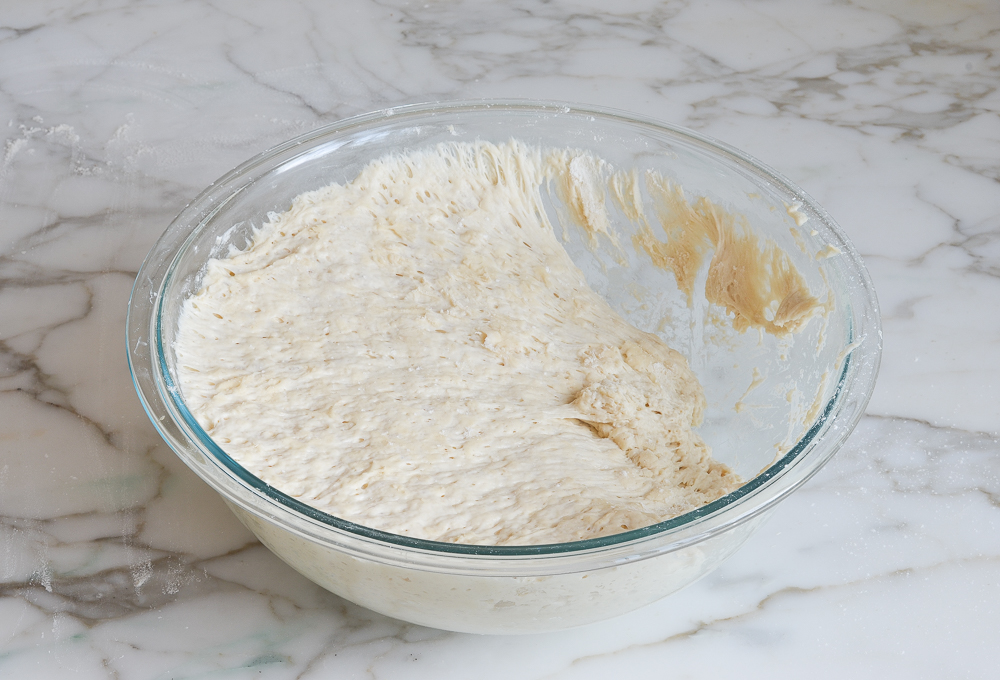
Coat the outside lightly with flour (you don’t want to incorporate more flour into the dough, you just want to be able to handle it). Gently work the dough into a smooth ball, stretching the surface and tucking the ends underneath.
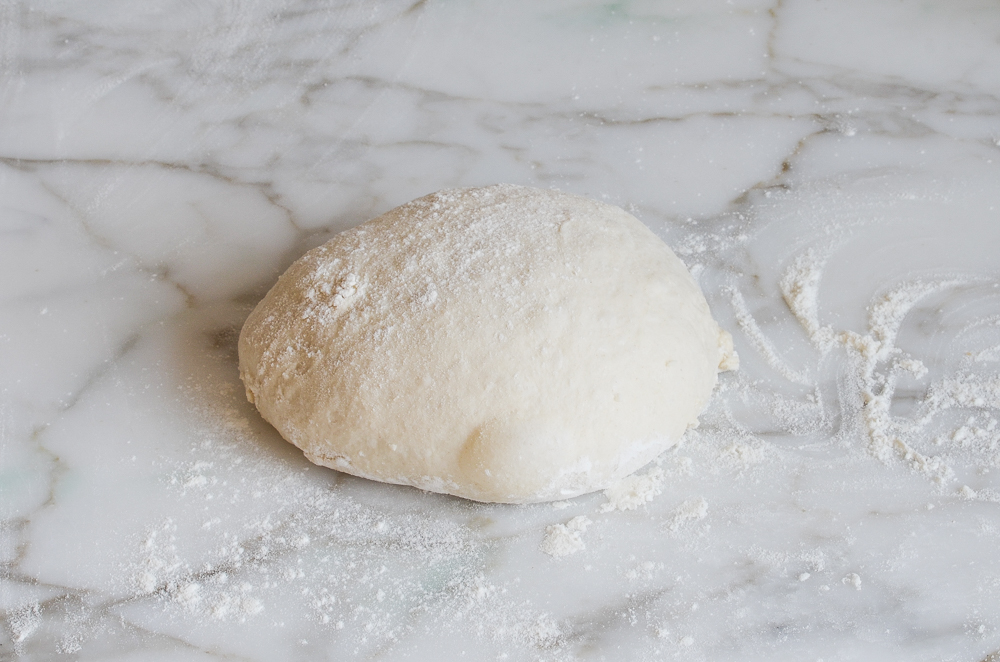
Put the dough ball onto a cornmeal-dusted baking sheet and let rest at room temperature, uncovered, for about 40 minutes. (If the dough has been refrigerated, allow it to rise for 60 minutes, or up to 90 minutes if you want a more open and airy crumb structure.) The dough will rise a bit. It may also spread/flatten a bit; that’s okay.
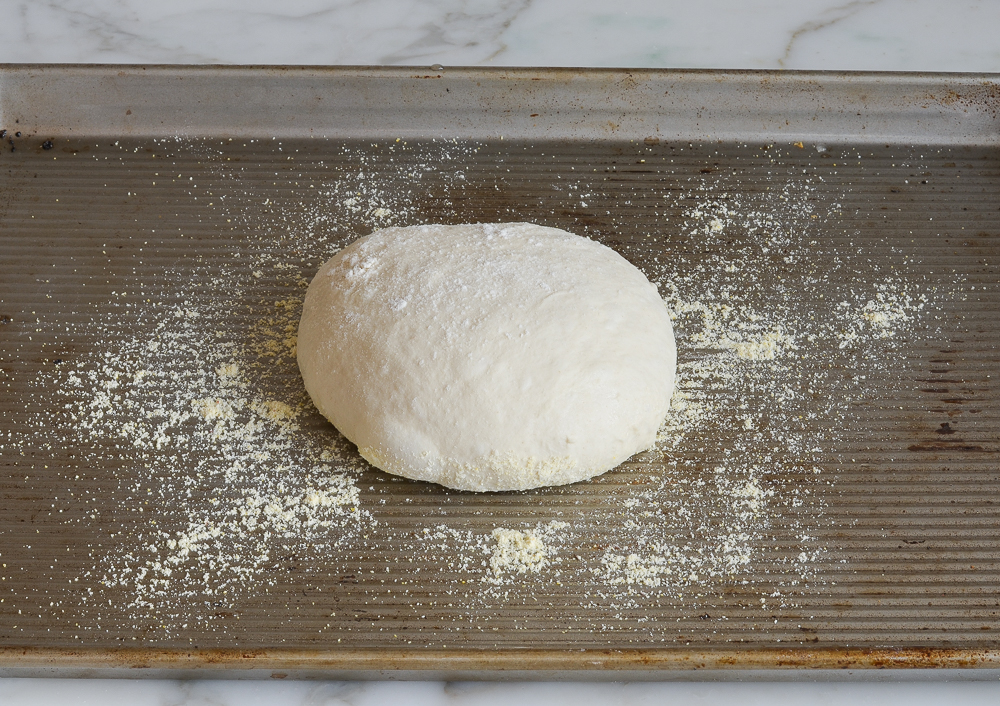
The dough will rise a bit.
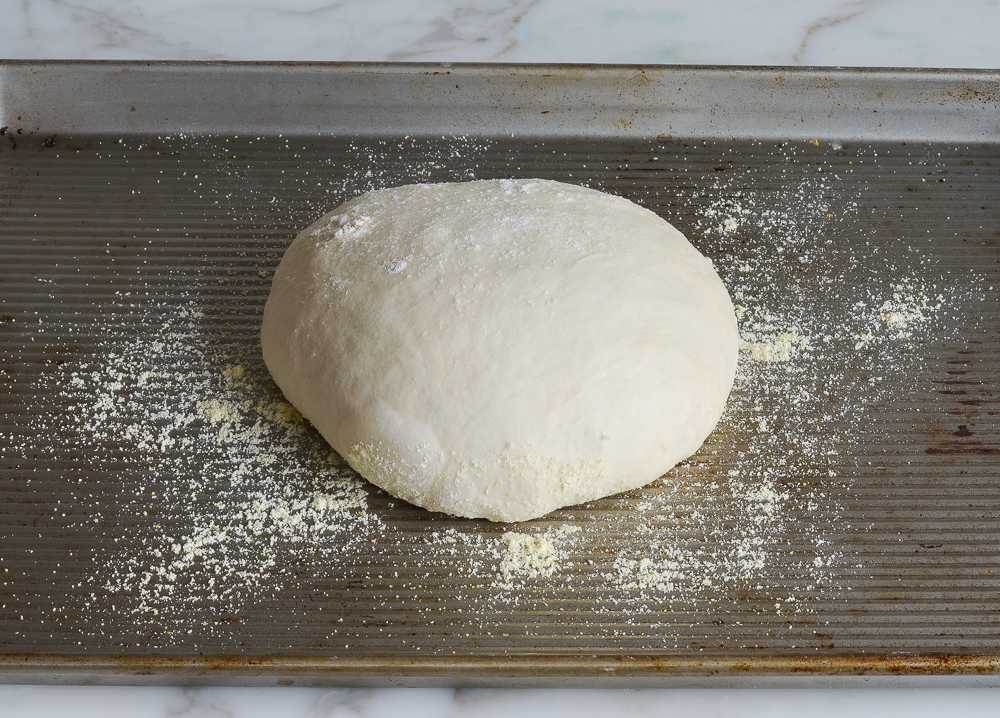
Generously dust the dough with flour. Using a sharp knife, make a few 1/2-inch-deep slashes in the dough — a scallop, cross, or tic tac toe pattern all look nice.
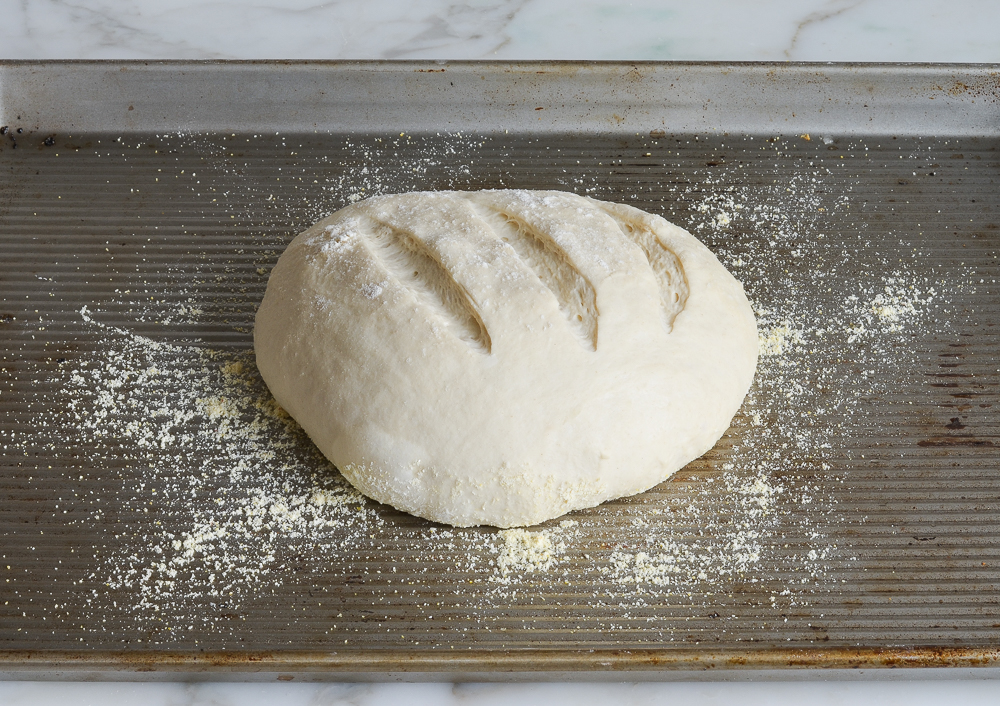
Set a metal pan on the bottom rack of a preheated 450°F-oven. Slide the baking sheet with the dough into the oven, and carefully fill the metal cake pan with one cup of hot tap water. This creates steam in the oven. (Try to do this quickly so as not to let heat out of the oven.) Bake until the loaf is golden brown, about 30 minutes. Cool completely on a wire rack.
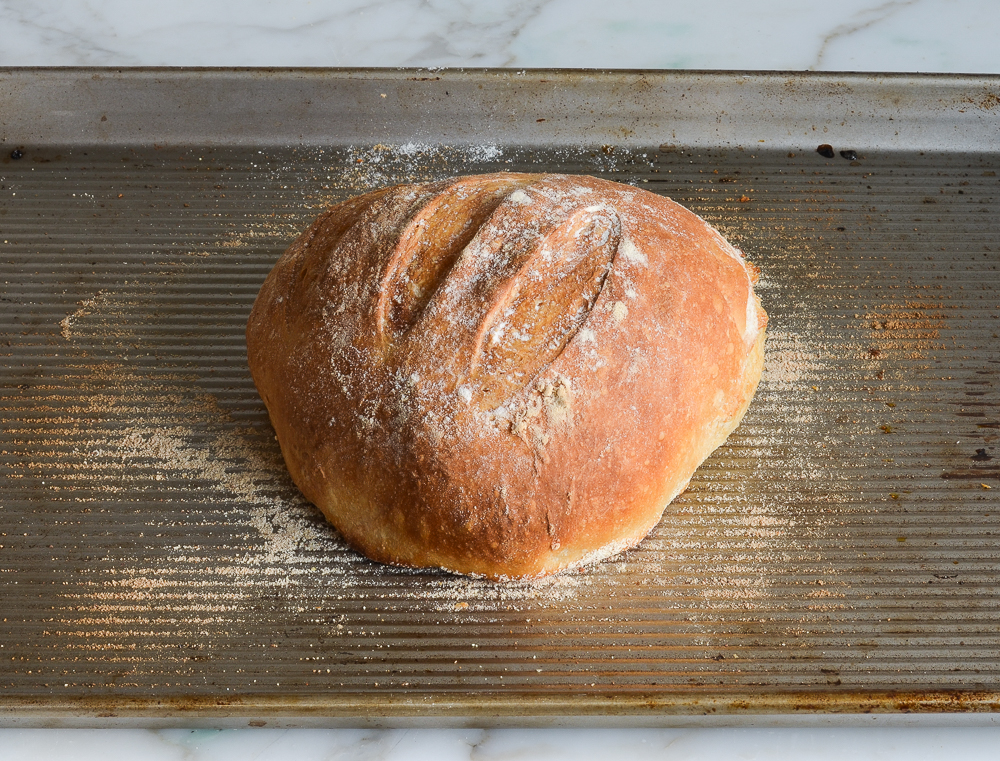
This bread is best enjoyed fresh on the day it is made. Once sliced, place the loaf cut-side down on a cutting board or plate and leave it uncovered.
Freezing Instructions
The dough can be portioned into thirds and frozen in airtight plastic containers for up to 1 month. Defrost the dough in the refrigerator overnight, then shape, rest and bake as usual. The baked loaves can also be frozen whole or sliced. Wrap in a zip-top freezer bag and freeze for up to 1 month. To thaw, take the bread out of the freezer and let it come to room temperature, about 3 hours. Reheat in a 350°F oven until warmed through, about 10 minutes.
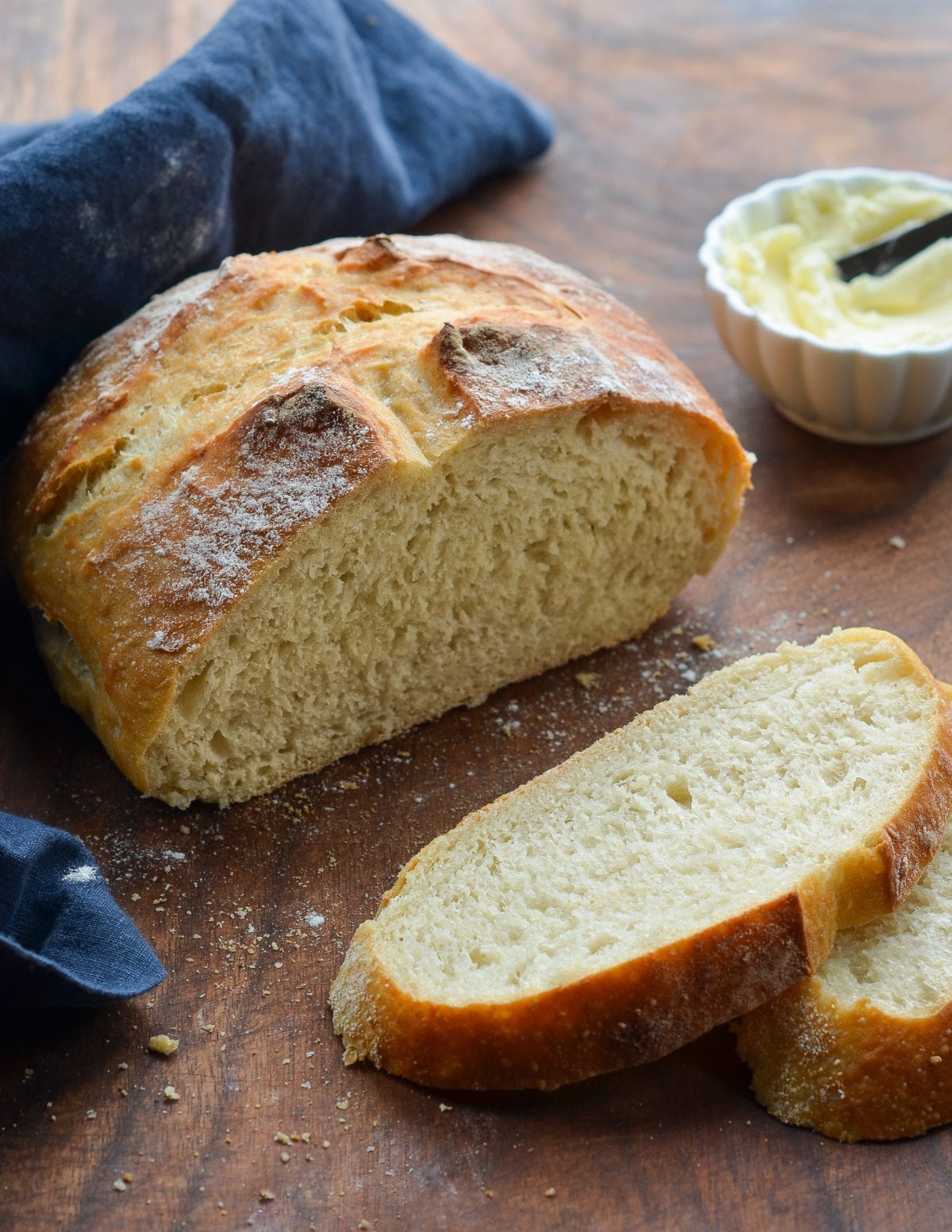
You May Also Like
Artisan Bread
This crusty bread recipe is astonishingly easy—no kneading required—and makes three beautiful loaves, which you can bake as needed.
Ingredients
- 6½ cups all-purpose flour, spooned into measuring cup and leveled-off (preferably King Arthur; see note)
- 4 teaspoons kosher salt
- 1½ tablespoons instant/rapid-rise yeast (see note)
- 3 cups lukewarm water (no need to be exact but lukewarm is about 100°F)
- Cornmeal, for dusting the pan
Instructions
- In a very large (6-quart) bowl, whisk together the flour, salt, and yeast. Add the water and stir with a wooden spoon until the mixture is uniformly moist, without any patches of flour. The dough should be sticky and conform to the shape of the bowl. If your dough is too dry, add a few tablespoons more warm water. If it's too wet, add a few tablespoons of flour. (See the step-by-step photos for guidance on what the dough should look like.) Cover the bowl loosely with plastic wrap and let it sit on the counter in a warm spot for 2 hours. If you plan to bake a loaf immediately, proceed to the next step. Otherwise, place the bowl of dough in the refrigerator to be used over the next 14 days. (Once refrigerated, the dough will shrink back a bit; that's okay. Do not punch down the dough at any point, and keep it loosely covered with plastic wrap.)
- Dust a sturdy baking sheet with cornmeal.
- Dust the surface of the dough and your hands lightly with flour. Pull out one-third of the dough and coat the outside lightly with flour (you don't want to incorporate more flour into the dough, you just want to be able to handle it). Gently work the dough into a smooth ball, stretching the surface and tucking the ends underneath, adding more flour as needed so it doesn't stick to your hands. (Don't overwork the dough; this process should only take about 30 seconds.) Put the dough ball onto the prepared baking sheet and let it rest at room temperature, uncovered, for about 40 minutes. (If the dough has been refrigerated, allow it to rise for 60 minutes, or up to 90 minutes if you want a more open and airy crumb structure.) The dough will rise a bit. It may also spread/flatten a bit; that's okay.
- Preheat the oven to 450°F. Set one rack in the lowest position of the oven and one rack in the middle position. Place a metal pan (any metal cake pan or broiler pan will work; just don't use glass) on the bottom rack. (You will fill this with water later to create steam in the oven).
- Generously dust the dough with flour. Using a sharp knife, make a few ½-inch-deep slashes in the dough -- a scallop, cross, or tic tac toe pattern all look nice.
- Slide the baking sheet with the dough into the oven, and carefully fill the metal cake pan with one cup of hot tap water. (Try to do this quickly so as not to let heat out of the oven.) Bake until the loaf is golden brown, about 30 minutes. Cool completely on a wire rack.
- This bread is best enjoyed fresh on the day it is made. Once sliced, place the loaf cut-side down on a cutting board or plate and leave it uncovered. (If it lasts beyond a day, I suggest slicing and freezing.)
- Freezer-Friendly Instructions The dough can be portioned into thirds and frozen in airtight plastic containers for up to 1 month. Defrost the dough in the refrigerator overnight, then shape, rest and bake as usual. The baked loaves can also be frozen whole or sliced: Wrap in a zip-top freezer bag and freeze for up to 1 month. (If you plan to use slices one at a time, place pieces of parchment between them so they don't stick.) To thaw, take the bread out of the freezer and let it come to room temperature on the countertop. Reheat in a 350°F oven until warmed through, about 10 minutes.
- Note: Active dry yeast may be used instead of instant/rapid-rise yeast, however, the dough will take longer to rise. To give active dry yeast a boost, you can dissolve it in the lukewarm water and let it sit until frothy, about 10 minutes. After that, add it to the flour and salt, and proceed with the recipe.
- Note: I use King Arthur flour, which is higher in protein than some other all-purpose flours. If using a flour with a lower protein content, such as Gold Medal, you will likely need to add a few more tablespoons of flour.
Nutrition Information
Powered by ![]()
- Serving size: 1 slice
- Calories: 100
- Fat: 0 g
- Saturated fat: 0 g
- Carbohydrates: 21 g
- Sugar: 0 g
- Fiber: 1 g
- Protein: 3 g
- Sodium: 64 mg
- Cholesterol: 0 mg
This website is written and produced for informational purposes only. I am not a certified nutritionist and the nutritional data on this site has not been evaluated or approved by a nutritionist or the Food and Drug Administration. Nutritional information is offered as a courtesy and should not be construed as a guarantee. The data is calculated through an online nutritional calculator, Edamam.com. Although I do my best to provide accurate nutritional information, these figures should be considered estimates only. Varying factors such as product types or brands purchased, natural fluctuations in fresh produce, and the way ingredients are processed change the effective nutritional information in any given recipe. Furthermore, different online calculators provide different results depending on their own nutrition fact sources and algorithms. To obtain the most accurate nutritional information in a given recipe, you should calculate the nutritional information with the actual ingredients used in your recipe, using your preferred nutrition calculator.

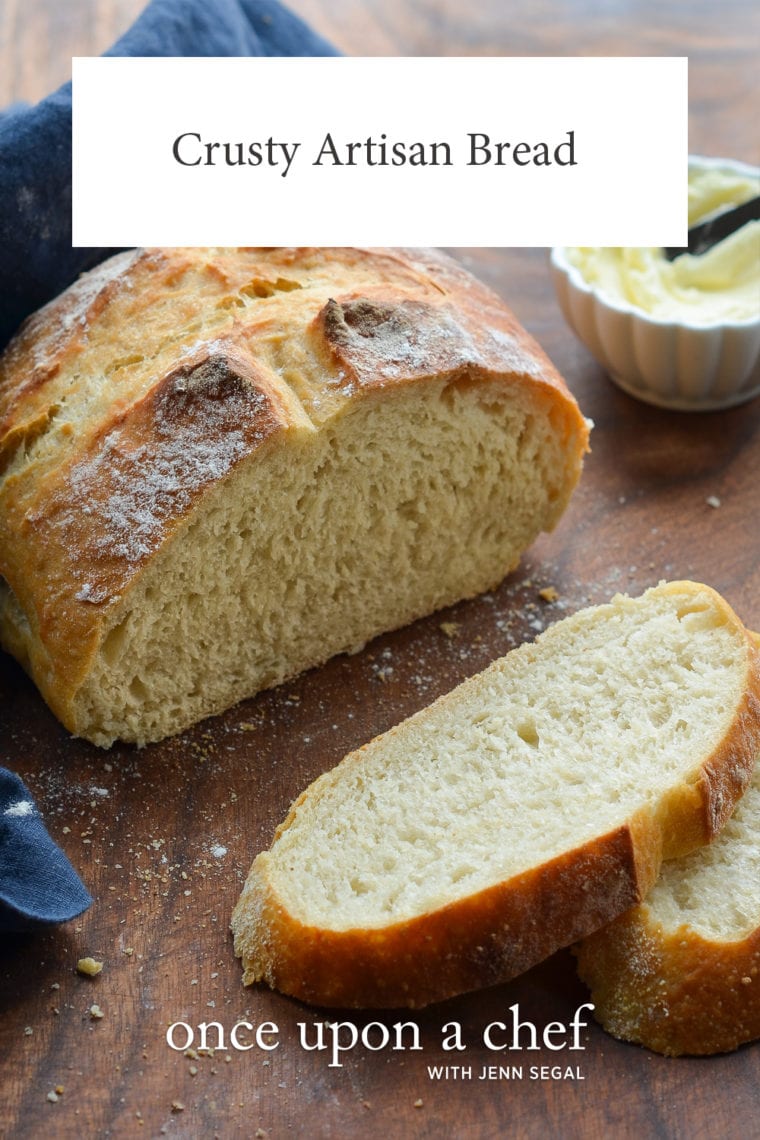
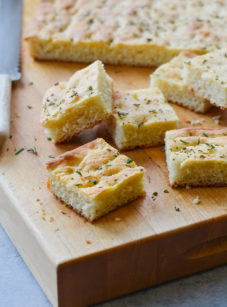
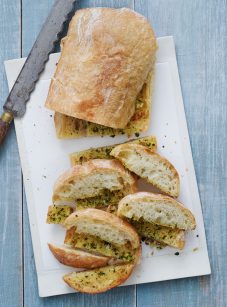
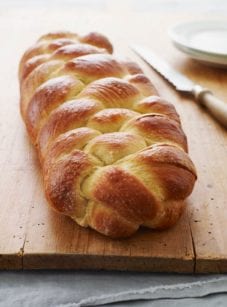
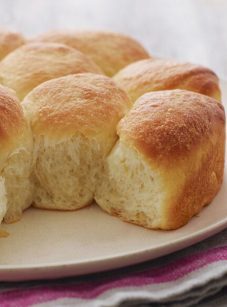
This was my first attempt making any bread,it was easy, smelled wonderful and tastes great.Served with soup & salad.Best part is we have two more!
Absolutely delicious. Great texture and crust but my loaf came out flat instead of rounded. What did I do wrong?
Hi Glenda, If the texture was good it’s likely that your yeast was fine, so you likely need to add a bit more flour next time.
Absolutely best bread ever
Easiest recipe for bread I have ever made
If I want to bake the bread in a regular bread pan, how many loafs will it make?
Hi Anneliese, I’d probably do 1/3 of the dough in each loaf pan. The cook time may be just a bit longer, but keep an eye on it. Be sure the pan is nonstick and grease it well. Also, if you have smaller loaf pans (8.5×4.5-in), those would be better.
Great! Just made a batch last night! My husband loves it! Question — how long would you say a fresh loaf is good for? What is the shelf life if just leaving it out at room temperature? Thank you!!
Hi Andrea, Fresh bread is usually only good for a day or two, but it freezes beautifully if you need to hold onto it longer.
I’m a novice, but feel like a pro! I made this today on a whim. It was simple to do, and the outcome is rustic and delicious. The texture is crusty and chewy, without being too dense. It’s the perfect artisan bread recipe for beginners. Thank you!
I made this recipe yesterday for a girl’s dinner to go with a main course chicken salad. Everyone loved this bread! As a professional break baker (I’ve developed many recipes for yeast bread and used to work for Pillsbury in their test kitchens), I found this recipe to be very easy and worked like a charm! I’m curious to experience this bread again after a few days to see how the flavor develops with time, since the flavor on the first day of making the dough was a bit bland without the addition of butter or oil. But still very pleasing, especially hot from the oven! Try it, you’ll like it.
Just as others have said, this is a fantastic recipe! I have a good friend who has terminal cancer and he requested homemade bread. I don’t own a bread machine and have never attempted making bread, but I’ve made several other recipes from this site and they have been keepers. This one did not disappoint either! I used regular flour and made two loaves – baked them two days later and they look like they were baked by a professional. I had to taste test with real butter and it was sooooo good! Thank you again!!!
Wow! This is a GREAT recipe! I’ve made a lot of bread in my life, but this is the first time I’ve made a yeast bread without sugar. I really doubted that it would rise, but it did! The crust is amazing! My husband said this recipe is a keeper, and I wholeheartedly agree. I only made one third of the recipe because I wanted to ensure the two of us would like it, and it was terrific. Many thanks for sharing.
So is this called “Artisan Bread” or is there a more specific name?
Additionally I’ve been halving the dough and putting it in bread pans so i can slice for sandwiches. This is a stellar recipe, I’ve done two batches today alone and proofing another (lol I won’t tell you how many I’ve done this week😬 )
Thanks alot, this is definitely going in the family recipe book!
I could literally make bread every single day. My favourite part of the process is the kneading so when I read this recipe, I was thinking of giving it a miss because of the “no-knead” required. So glad I didn’t! I halved the recipe and used Roger’s brand unbleached flour (I am in Canada and it is a fairly popular brand, depending on where you are in our country). I made 2 small loaves and they are PERFECT. My husband, who loves fresh bread said he could have eaten the entire loaf that I sliced up at supper time. Simply delish and so easy to make. I think this will be my new go-to recipe!!